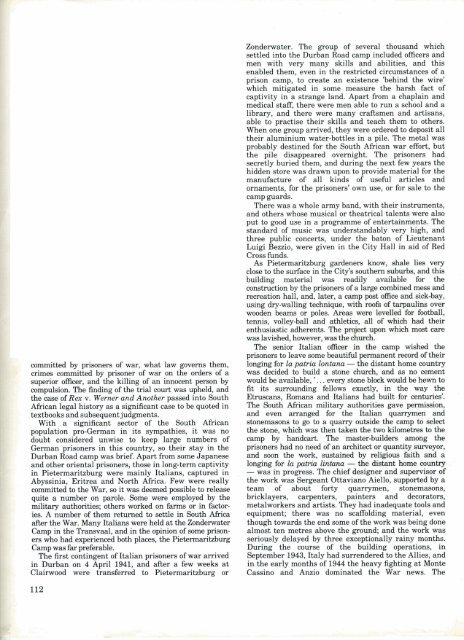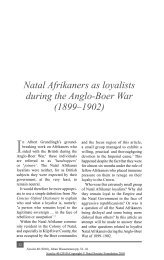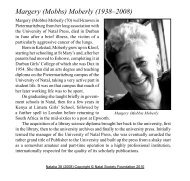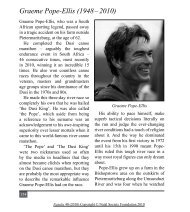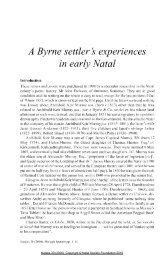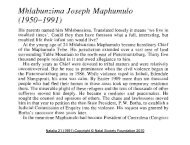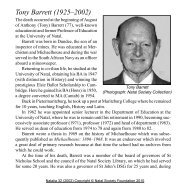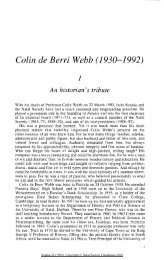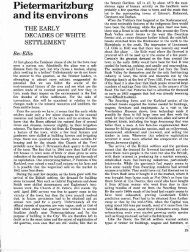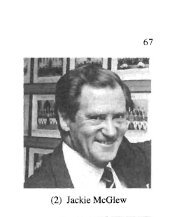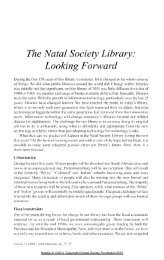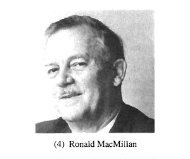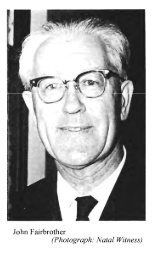Zonderwater. The group of several thousand whichsettled into the Durban Road camp included officers andmen with very many skills and abilities, and thisenabled them, even in the restricted circumstances of aprison camp, to create an existence 'behind the wire7which mitigated in some measure the harsh fact ofcaptivity in a strange land. Apart from a chaplain andmedical staff, there were men able to run a school and alibrary, and there were many craftsmen and artisans,able to practise their skills and teach them to others.When one group arrived, they were ordered to deposit alltheir aluminium water-bottles in a pile. The metal wasprobably destined for the South African war effort, butthe pile disappeared overnight. The prisoners hadsecretly buried them, and during the next few years thehidden store was drawn upon to provide material for themanufacture of all kinds of useful articles andornaments, for the prisoners' own use, or for sale to thecamp guards.There was a whole army band, with their instruments,and others whose musical or theatrical talents were alsoput to good use in a programme of entertainments. Thestandard of music was understandably very high, andthree public concerts, under the baton of LieutenantLuigi Bezzio, were given in the City Hall in aid of RedCross funds.As <strong>Pietermaritzburg</strong> gardeners know, shale lies veryclose to the surface in the City's southern suburbs, and thisbuilding material was readily available for theconstruction by the prisoners of a large combined mess andrecreation hall, and, later, a camp post office and sick-bay,using dry-walling technique, with roofs of tarpaulins overwooden beams or poles. Areas were levelled for football,tennis, volley-ball and athletics, all of which had theirenthusiastic adherents. The project upon which most carewas lavished, however, was the church.The senior Italian officer in the camp wished theprisoners to leave some beautiful permanent record of theircommitted by prisoners of war, what law governs them, longing for la patria lontana - the distant home countrycrimes comm,itted by prisoner of war on the orders of a was decided to build a stone church, and as no cementsuperior officer, and the killing of an innocent person by would be available, '... every stone block would be hewn tocompulsion. The finding of the trial court was upheld, and fit its surrounding fellows exactly, in the way thethe case of Rex v. Werner and Another passed into South Etruscans, Romans and Italians had built for centuries'.African legal history as a significant case to be quoted in The South African military authorities gave permission,textbooks and subsequent judgments.and even arranged for the Italian quarrymen andWith a significant sector of the South African stonemasons to go to a quarry outside the camp to selectpopulation pro-German in its sympathies, it was no the stone, which was then taken the two kilometres to thedoubt considered unwise to keep large numbers of camp by handcart. The master-builders among theGerman prisoners in this country, so their stay in the prisoners had no need of an architect or quantity surveyor,Durban Road camp was brief. Apart from some Japanese and soon the work, sustained by religious faith and aand other oriental prisoners, those in long-term captivity longing for la patria lintuna - the distant home countryin <strong>Pietermaritzburg</strong> were mainly Italians, captured in - was in progress. The chief designer and supervisor ofAbyssinia, Eritrea and North Africa. Few were really the work was Sergeant Ottaviano Aiello, supported by acommitted to the War, so it was deemed possible to release team of about forty quarrymen, stonemasons,quite a number on parole. Some were employed by the bricklayers, carpenters, painters and decorators,military authorities; others worked on farms or in fador- metalworkers and artists. They had inadequate tools andies. A number of them returned to settle in South Africa equipment; there was no scaffolding material, evenafter the War. Many Italians were held at the Zonderwater though towards the end some of the work was being doneCamp in the Transvaal, and in the opinion of some prison- almost ten metres above the ground; and the work wasers who had experienced both places, the <strong>Pietermaritzburg</strong> seriously delayed by three exceptionally rainy months.Camp was far preferable.During the course of the building operations, inThe first contingent of Italian prisoners of war arrived September 1943, Italy had surrendered to the Allies, andin Durban on 4 April 1941, and after a few weeks at in the early months of 1944 the heavy fighting at MonteClairwood were transferred to <strong>Pietermaritzburg</strong> or Cassino and Anzio dominated the War news. The
foundation stone had been ceremonially laid on 2February 1943. Thirteen and a half months later, onSunday 19 March 1944, the Apostolic Delegate to SouthAfrica, Archbishop van Gijlswijk, inaugurated andconsecrated the church. The ceremony and the HighMass which followed it were charged with emotion forthe hundreds of Italian prisoners who participated -pride in a great creative effort completed, relief that theWar seemed to be moving to its end, but also fear thatItaly would still have to endure months of bitter fightingas the Allies slowly drove the German forces northwards.To mark the occasion a commemorative booklet wasprinted, entitled In Attesa (While Waiting), describingthe church-building project, giving an account of themany other activities with which the prisoners tried toalleviate the misery of captivity, and ending with amemorial page dedicated to eight soldiers who died inthe camp and are buried in the Mountain Rise cemetery.Despite its unhappy associations for the prisoners, andthe fact that most of them could have seen little of theCity except the admittedly attractive panorama ofSwartkop and the Town Hill, there are severalcomplimentary references to Pieterrnaritzburg, and nodoubt there are to this day copies of In Attesa in homesall over Italy, nostalgically read by elderly men whowere i prigionieri di guerra Italiani, del campo di <strong>Pietermaritzburg</strong>.1 Hay Paddock Transit CampHay Paddock Camp was under construction during July1942, with aneauthorized expenditure of $157 000 for thevarious civil engineering works required. By the end ofI that month 3 212 Polish troops with 34 officers, and 1484Royal Navy personnel with 32 officers, were alreadyencamped. As the Union Defence Force camp staffnumbered only 4 officers and 12 other ranks, a report tothe Deputy Adjutant General considered that 'immediateassistance in the way of increased staff [was] essential'.This was forthcoming, and Hay Paddock was thereafterappropriately staffed except, as we shall see, for securitypersonnel.The 181-acre (72 hectare) site was divided into twentyblocks, each to accommodate 1000 men, mostly in tents. Itwas intended to house Union Defence Force units inreadiness for embarkation, to relieve congestion in theDurban transit camps (such as Clainvood), and 'toaccommodate troops of the Allied Nations while in transit'.Its average occupancy was 15000, but at peak periods asmany as 25000 were in camp. Perhaps the largest singleIinflux of South African troops occurred in 1943. On NewYear's Day advance parties of the 1st South AfricanDivision arrived back from Egypt, and two weeks later theI main body of the Division followed. Although they were all1;werei 'dispersed on home leave by 18 January, the camp facilitiestemporarily under severe strain, and none more sothan the small camp post office as the returning men allwrote to tell their families that they were back on SouthAfrican soil. Defence Headquarters in Pretoria had beenadvised that the post ofice at Hay Paddock should be'. . . conservatively staffed at first, as the mail of the Alliedtroops is very small [Polish troops never get any]'.The short parenthesis of the reporting officer is apoignant reminder of the complete lack of contact betweellmany of the continental troops and their families inoccupied Europe. Small wonder, therefore, that their stayat Hay Paddock was hardly a happy time for the greatmajority of troops. The tented camp was bitterly cold onwinter nights, and in spring and summer rain madeconditions very trying. The inmates referred to the place as'Clay Paddock'. Some, after unfortunate experiences in thecrowded tents, called it 'Flea Paddock'!Camp security was a constant problem, with petty theftrife, and the camp authorities unable to bring the culpritsto book or take preventive measures. Using members ofunits in camp for gate duty and general security hadproved unsatisfactory, and in March 1943 thecommandant, Lieutenant-Colonel Stewart-Dunkerley,made a strong request for police personnel as an integralpart of the camp staff.It was mainly Hay Paddock which accounted for theubiquity of uniformed troops in <strong>Pietermaritzburg</strong> streets.Ten different places catering for servicemen and womenwere listed during those years, run by serviceorganizations such as the YMCA, Toc H, and the SouthAfrican Women's Auxiliary Services (SAWAS). Perhapsthe best known was the Soldiers' Club, in a handsome oldcommercial building at 168 Longmarket Street, oppositeSt. Peter's Church grounds. (The building survived formany years after the War, used by various firms, but wasdemolished to make way for the open-air parking lot nowoccupying the site.) Every Tuesday night there was aUniform Dance in the City Hall from 7.30 till 10.30 p.m.Bars and hotels also attracted men with time and money tospare, and the civil and military police ohn had theirhands full when things became too rough. At one timemilitary police were given a list of useful foreign phrases(phonetically spelt) to enable them to communicate withthose who were lost, drunk, or both. Even though it waswartime, it was a boom time for 'the bioscope', and onFriday 19 September 1941 the 20th Century Cinema inLongmarket Street opened as the City's fourth and mostmodern cinema. Not one of these cinemas - the Excelsior,the King's, the Grand and the 20th Century - remains.The 20th Century finally closed its doors during 1986, butthere must be many ex-soldiers all over the world whoremember it as it was then, with the paint hardly dry andthe newsreels providing a carefully controlled descriptionof the War's progress.<strong>Pietermaritzburg</strong>, like other South African cities, wasfar removed from any war zone. There were some foodshortages and some rationing; there were blackoutregulations and air-raid drills, which citizens observedwithout for a moment believing that they would ever seethe real thing. But the three large camps we havediscussed constantly and forcibly reminded even thosetownspeople who had no relatives in the armed forces thatthe world was in turmoil. Not only were offdutyservicemen a common sight in the streets, but there werethe long columns of men, accompanied, ohn, by bandsplaying, armoured cars, guns and gunkages, marchingto and from the railway station along Commercial Roadand Church Street. For the schoolboys who hung over thefences to watch, they simply provided more inspiration forthe war games they played with such gusto. Others sawthem come and go with the mixture of pride and sorrowwhich such sights have always brought.


